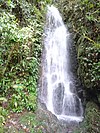ഭൂഗർഭജല മലിനീകരണം

ഭൂഗർഭജല മലിനീകരണം സംഭവിക്കുന്നത് ഭൂമിയിലേക്ക് മാലിന്യങ്ങൾ വിടുമ്പോൾ അവ ഭൂഗർഭജലത്തിൽക്കലർന്നാണ്. ഭൂഗർഭജലത്തിലെ ലഘുവും ആവശ്യമില്ലാത്തതുമായ ഘടകം, മലിനീകരണവസ്തു അല്ലെങ്കിൽ അശുദ്ധപദാർത്ഥം എന്നിവ മൂലം ഇത് പ്രകൃത്യാ സംഭവിക്കാം. ജലത്തിന്റേയും ചലനവും വെള്ളത്തെ ഉൾക്കൊള്ളുവാനും അതിനു ചലിക്കുവാനും ഇടംനൽകുന്ന പാറക്കെട്ടുകൾക്കുള്ളിലേടെയുള്ള വ്യാപനവും കൂടുതൽ മേഖലകളിലേക്ക് മാലിന്യവസ്തുവിനെ വ്യാപിപ്പിക്കുന്നു.
വിവിധതരം മലിനീകരണവസ്തുക്കൾ
[തിരുത്തുക]ആർസെനിക്കും ഫ്ലൂറൈഡും
[തിരുത്തുക]ലോകവ്യാപകമായി കുടിവെള്ളത്തിലെ ഏറ്റവും ഗൗരവകരമായ അജൈവ മലിനീകരണവസ്തുവായി ലോകാരോഗ്യസംഘട അംഗീകരിച്ചിരിക്കുന്നത് അർസനിക്കും ഫ്ലൂറൈഡുമാണ്. [1]
ചൈന, ഇന്ത്യ, ബംഗ്ലാദേശ് ഉൾപ്പെടുന്ന ഏഷ്യയിൽ ഭൂഗർഭജലത്തിൽ മെറ്റലോയിഡ് ആർസനിക്ക് പ്രകൃതിദത്തമായി കാണപ്പെടുന്നു. [2]
രോഗകാരികളായ സൂക്ഷ്മജീവികൾ
[തിരുത്തുക]നൈറ്റ്രേറ്റ്
[തിരുത്തുക]അവലംബം
[തിരുത്തുക]- ↑ World Health Organization (WHO) (2006). "Section 1:Managing the Quality of Drinking-water Sources". In Schmoll,O; Howard, G; Chilton G (eds.). Protecting Groundwater for Health: Managing the Quality of Drinking-water (PDF). IWA Publishing for WHO.
- ↑ Ravenscroft,P (2007). "Predicting the global extent of arsenic pollution of groundwater and its potential impact on human health" (PDF). UNICEF. Archived from the original (PDF) on 2017-03-19. Retrieved 2017-06-02.
Underground water എന്ന വിഷയവുമായി ബന്ധപ്പെട്ട ചിത്രങ്ങൾ വിക്കിമീഡിയ കോമൺസിലുണ്ട്.
